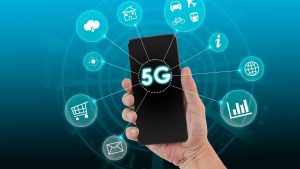Introduction Remote work has changed how we live and work. In 2025, the rise of 5G remote work is set to change it again. Unlike past connections, 5G speed offers ultra‑fast downloads and near-zero delays. This leap makes calls sharper, video smoother, and collaboration real‑time. It helps teams share big files instantly, run virtual meetings
Introduction
Remote work has changed how we live and work. In 2025, the rise of 5G remote work is set to change it again. Unlike past connections, 5G speed offers ultra‑fast downloads and near-zero delays.
This leap makes calls sharper, video smoother, and collaboration real‑time. It helps teams share big files instantly, run virtual meetings without lag, and even explore AR/VR conferencing tools. As we rely more on home offices and coworking spaces, the impact of 5G on remote work grows clear.
What Is 5G?
5G stands for the fifth generation of wireless networks. It uses new radio waves and advanced cell towers. Compared to 4G, 5G speed can be up to 100 times faster.
That means you can download a high‑definition movie in seconds. Its low latency—the tiny delay before data moves—drops from around 50 milliseconds to 1–5 milliseconds.
In everyday terms, that makes online gaming, video calls, and remote controls feel instant. This new network also handles more devices at once. As our homes fill with smart gadgets, 5G for remote teams ensures everything stays connected smoothly.
Current Challenges in Remote Work
Many Remote Workers still face slow connections and dropped calls. Large video files take forever to upload. Teams rely on cloud tools, but slow internet makes collaboration painful. Lag in video meetings can cause people to talk over each other or miss key points.
In some areas, Wi‑Fi is spotty or home networks get bogged down when family members stream movies. Security is another worry. Public Wi‑Fi risks data leaks. Even VPNs can slow things down further. These issues add stress and lower productivity.
How 5G Addresses Remote Work Challenges
With 5G remote work, speed and reliability improve dramatically. Fast upload and download rates mean sharing large presentations or design files takes seconds, not minutes. Low latency makes video meetings feel like in‑person chats. No more frozen screens or delayed audio.
High capacity means many devices—laptops, phones, smart speakers—can all stay connected without slowing the network. New features like network slicing let businesses reserve dedicated bandwidth for critical apps. This keeps work calls clear even when others in your home stream videos. Overall, the impact of 5G on remote work is huge: fewer hiccups and more focus on the task at hand.
Key 5G Applications in Remote Work

Image by: Yandex.com
High‑Definition Video Conferencing
Gone are pixelated calls and awkward freezes. With 5G speed, you can run 4K video meetings that rival in‑office face‑to‑face chats. Tools like Zoom and Teams will auto-adjust to deliver crisp picture and clear sound.
AR/VR Conferencing
Imagine wearing a simple headset and stepping into a virtual meeting room with life‑like avatars. AR/VR conferencing becomes practical with low latency. Architects can walk clients through virtual models. Designers can sketch in 3D. This hands‑on collaboration feels real.
Edge Computing
Edge computing places data processing near you rather than in distant data centers. This cuts delays even further. For remote teams using AI tools—like real‑time transcription—edge networks make replies instant and reliable.
Smart IoT Device Control
From smart whiteboards to remote office lighting, 5G for remote teams lets you manage IoT devices seamlessly. You can adjust your home office lights, lock doors, or start your coffee maker via app without lag.
Instant File Sharing
Teams that work with large files—video editors, engineers, and marketers—love 5G speed. Uploading or downloading gigabyte‑sized files is nearly instant, keeping projects on schedule.
Sector Impacts of 5G in Remote Work

Image by: Yandex.com
Education
Teachers can host interactive classes with live experiments via high‑res video. 5G remote work lets students join VR labs and virtual field trips from home. No more lagging shared screens.
Healthcare
Doctors perform remote exams with real‑time high‑definition video. IoT health devices send data instantly, letting doctors monitor patients’ vitals at home. 5G in healthcare means fast, secure, and reliable care.
Creative Industries
Film editors, animators, and game designers collaborate in the cloud without waiting for uploads. They can work on the same large files simultaneously, thanks to edge computing and 5G speed.
Fieldwork and Construction
Workers on sites use AR headsets to view blueprints overlaid on real buildings. Data streams flawlessly over 5G, guiding inspections and repairs in real time.
How 5G Is Enhancing Remote Work in 2025

Image by: Yandex.com
Faster and More Reliable Internet Connections
One of the biggest challenges for remote workers has always been internet speed and reliability. Slow internet can disrupt video conferences, cause delays in file transfers, and lead to frustration.
How This Benefits Remote Workers:
- Improved video calls: 5G makes it easier to participate in video calls without interruptions or poor-quality connections, making virtual meetings more effective and professional.
- Quicker file transfers: With 5G, large files can be uploaded or downloaded in seconds, helping workers stay productive and meet deadlines faster.
- Seamless access to cloud tools: Remote workers can access cloud-based tools and services without delays, making collaboration on documents, presentations, and projects easier.
Better Collaboration Tools
5G makes these tools faster and more efficient. Cloud-based apps, such as Google Workspace, Microsoft 365, and project management platforms like Trello or Asana, rely on a strong internet connection to function smoothly. With 5G, these apps work more seamlessly, allowing teams to collaborate in real-time without the lag.
How This Benefits Remote Workers:
- Faster document sharing: Workers can edit and share documents in real-time without worrying about lag or syncing issues.
- Enhanced virtual collaboration: Tools like Zoom, Microsoft Teams, or Slack work better with 5G, improving communication and teamwork across distances.
- Access to advanced features: As more businesses move to cloud-based software, 5G enables the use of advanced features like AI-driven project management, real-time analytics, and enhanced data visualization.
Supporting Remote Teams with Better Connectivity
It enables businesses to invest in digital tools that require high-speed internet, such as virtual reality (VR) or augmented reality (AR) for team collaboration, training, or client presentations. These tools allow employees to work together as if they were in the same room, even if they’re across the globe.
How This Benefits Remote Teams:
- More engaging training: VR and AR-powered training sessions can be delivered remotely, helping employees learn new skills in an interactive way.
- Global collaboration: 5G makes it easier for teams from different parts of the world to collaborate on projects, attend meetings, and share resources without connection issues.
Tips to Leverage 5G in Remote Work

Image by: Yandex.com
Upgrade Your Devices
Ensure your phone, tablet, or laptop has a 5G modem. Older gear may not support the new network.
Use a 5G Hotspot
If your home Wi‑Fi is weak, use a dedicated 5G speed hotspot for reliable connections.
Secure Your Network
Always enable VPNs and two‑factor authentication. 5G is fast, but safety remains key.
Optimize Bandwidth
Reserve slices of your 5G plan for work calls or critical apps. This prevents slowdowns when family streams shows.
Test New Tools
Try AR/VR conferencing or edge‑based AI assistants. Early adopters gain a head start in productivity.
Table: 5G Benefits for Remote Work
| Benefit | How It Helps |
|---|---|
| Ultra‑Fast Speed | Quick file sharing and downloads |
| Low Latency | Smooth, real‑time video calls and VR meetings |
| High Capacity | Many devices online without slowdowns |
| Edge Computing | Instant AI and data processing |
| Network Slicing | Dedicated bandwidth for key tasks |
Conclusion
With 5G speed and low latency, everyday tasks like video conferencing and file sharing become seamless.
By Upgrading Devices, securing connections, and testing new features, you can fully embrace this fast, reliable network. Ready to supercharge your home office?
















